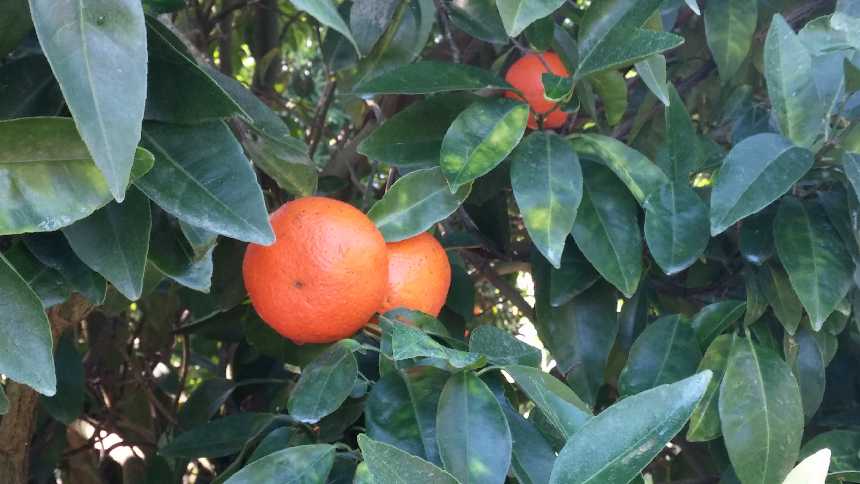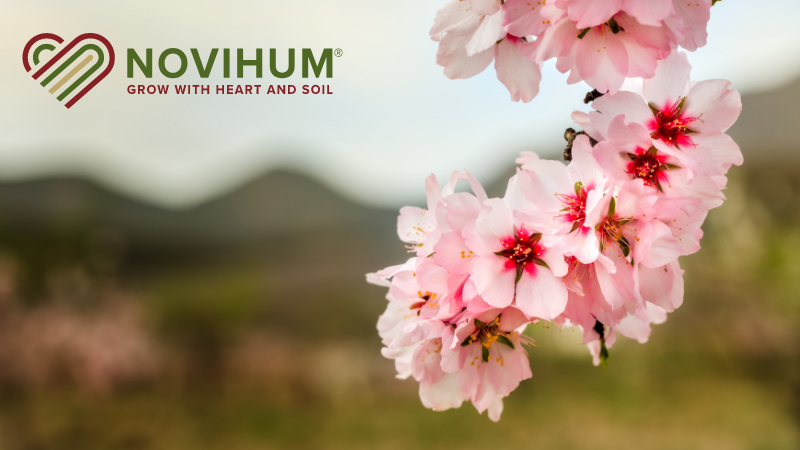Sounds Like Chime Is Right For Sugar Belle LB 8-9

Photo courtesy of UF/IFAS
It is not uncommon for citrus varieties to gain a second wind or a new life as circumstances change. Such appears to be the case with Sugar Belle brand LB 8-9. Dr. Fred Gmitter first observed the LB 8-9 in a trial block in 1985 and it was ultimately approved for release by the University of Florida in 2006. Experimental trial plantings with private cooperators in commercial settings provided data to substantiate the release, opportunities for observation, and acreage that would later serve as the launchpad for commercial production.
Sugar Belle brand LB 8-9 was the first UF/IFAS commercial citrus release and the first citrus variety patented and trademarked by Florida Foundation Seed Producers Inc. (FFSP). Growers were initially intrigued by a variety that resembled Minneola, but that matured in time for the lucrative Christmas and Hanukkah gift giving season. Furthermore, the LB 8-9 had better color (internal and external), better flavor (robust and rich), and resistance to alternaria (which has plagued Minneola growers for years in the absence of effective control measures).
After the publication of an Invitation to Negotiate (ITN), FFSP awarded New Varieties Development & Management Corp. (NVDMC) an exclusive license to commercialize Sugar Belle brand LB 8-9 in the U.S. The variety has since been licensed through the ITN process to a second firm for trial and possible international commercialization.
However, LB 8-9s early years were not without their challenges. At the time of its release, HLB was rapidly spreading and its effects were intensifying. Young trees of LB 8-9 quickly began to show vein yellowing and blotchy mottle. Knowing of Minneola’s sensitivity to HLB, some growers grew fearful that LB 8-9 was equally sensitive to the disease.
Uncertainty in the future of Florida citrus in general discouraged new cultivar plantings. Some cancellation of orders occurred, while others moved into a wait-and-see mode. The loss of Minneola acreage due to HLB and alternaria lessened the number of growers active in the specialty tangelo-type marketplace. What was hoped to be a successful launch suddenly ground to a stop.
In the years since its introduction, trial acreage was converted to commercial production and some growers proceeded with small-scale LB 8-9 plantings. Ten packinghouses were licensed to pack Sugar Belle brand fruit produced from LB 8-9 trees, and packed fruit was sold to commercial retail stores, gift markets, and even on cable shopping networks. Despite the popularity of the fruit with consumers, and a high “likely to purchase” rating in consumer tests, LB 8-9 acreage remained flat. The 14 nurseries licensed to propagate LB 8-9 grew frustrated at the lack of orders and a large percentage of the registered budwood trees were removed. In some cases, trees that were previously registered as LB 8-9 scion trees were sold to homeowners. Though DPI and private nurseries continue to maintain budwood source trees, Florida’s capacity to quickly plant large quantities of LB 8-9 was significantly diminished.
Fast forward to 2015. Growers have learned a great deal about citrus production amid the challenges presented by HLB. Nutritional programs have been fine-tuned and some varieties are responding better than others. LB 8-9 trees that previously appeared to be succumbing to HLB came roaring back. This phenomenon was not isolated to specific groves, soils, or conditions. LB 8-9 trees began to stand out wherever they were planted. The foliage changed from yellow to dark green and premature fruit-drop didn’t seem to be an issue. Suddenly, growers gravitated to LB 8-9s overall tree health and the prospect of producing a viable crop of quality fruit. NVDMC began to receive inquires and requests for contracts. Growers wanted to see plantings of Sugar Belle brand LB 8-9 to verify for themselves the legitimacy of the stories. Budwood demand began to substantially exceed supply.
Though it remains to be seen how much of this renewed interest in Sugar Belle brand LB 8-9 will translate to orders, acreage, and production, it does illuminate the willingness of Florida citrus growers to replant if a viable option becomes available. It certainly causes one to imagine the impact of improved tolerance in round orange and grapefruit varieties. The demand remains strong; nurseries and growers simply need the tools and a boost in confidence.
On the following pages are some additional facts about Sugar Belle brand LB 8-9 as provided by Dr. Fred Gmitter, Dr. Jude Grosser, Dr. Bill Castle, and NVDMC.
What is the difference between LB 8-9 and Sugar Belle?
NVDMC: LB 8-9 is the name of the variety. Sugar Belle is a trademarked brand. Though fruit of LB 8-9 is the only variety currently marketed under the Sugar Belle trade name, FFSP and UF/IFAS may identify more varieties (exhibiting similar characteristics) with a wider range of fruit maturity dates in the future — that can be moved under the Sugar Belle umbrella.
After observing LB 8-9 for many years, what are the best rootstocks?
Gmitter, Grosser: LB 8-9 does well on most rootstocks that have been tested. Some of the more recent UFR releases bring it into bearing earlier. Only Cleo raises some concerns as acidity remains too high in some seasons, and fruit are not able to be shipped before they are too soft and arrive in poor condition.
Are there any rootstock incompatibilities?
Gmitter: We are not aware of any incompatibilities.
What are the present challenges with budwood?
NVDMC: Most of the available wood remains in private nursery hands. This presents another challenge, as some nurseries are willing to accept budwood from another nursery, while others are not. DPI has limited budwood source trees in Chiefland.
Does it grow well in all areas of the state? All soils?
Gmitter: So far, it looks good in every location it has been planted. It colors earlier in the Ridge than on the East Coast in some seasons. In the Indian River region, it can have a green stem end when the weather has been warm.

Photo courtesy of UF/IFAS
Considering its vigor, do you recommend a dwarfing rootstock?
Gmitter, Grosser: It is very vigorous, and the growers with experience have learned to cut it strongly. In one test of tree size controlling rootstocks, the best UF stocks for overall tree health and fruit quality were on UFR-5 and trifoliate orange 50-7. Dr. Castle’s observation (from early trials at Conserv II) was that medium-tree size-producing rootstocks provide the best combination of manageable growth and good yield.
What is a characteristic of LB 8-9 that frustrates some growers?
NVDMC: A narrow harvest window is one particular challenge. In addition, LB 8-9 is a variety with high acid and high brix. However, it does not achieve its superior flavor until the acid drops to an acceptable level. Depending on conditions, acid may hold longer than expected, causing scheduling conflicts with retailers.
With a tendency for high acidity, what rootstocks help limit the acid and make earlier harvest possible?
Gmitter: Cleo, again. Results in higher acid, but on Carrizo the acidity drops more quickly. Sour and Swingle are intermediate to CZO and Cleo. Growers potentially can extend the season by rootstock choices. Soon after HLB began to show itself, LB8-9 trees were reported to have symptoms. It was thought by some — to be highly susceptible. Fast forward to present. LB8-9 trees appear to be among the healthiest citrus trees in Florida.
Is LB 8-9 truly HLB-tolerant or does it respond more favorably than most varieties to nutritional programs?
Gmitter: Both statements are true. The tree itself really seems to tolerate HLB, but the fruit can be impacted. However, with good nutrition, it seems to have fewer or no HLB-symptomatic fruit. Some growers have also seen that crop load management can decrease the amount of HLB-impacted fruit through early season hedging. We have a lot more to learn about this.
LB 8-9 is known to get seedy in the presence of viable pollen. What is a safe distance from other pollen sources? Are certain varieties more problematic as far as causing LB 8-9 to seed-up?
Gmitter, Castle: This is difficult to answer. We don’t have a lot of experience. Among the first plantings, the first six to eight rows of LB 8-9 trees had seedy fruit when planted near Murcott trees. Other plantings have shown lower seed counts near various pollen sources. Some growers have used gibberellic acid (GA) at bloom time and greatly increased fruit set; but at the expense of fruit size. (Although, the smaller fruit was easier peeling and had low numbers of seed or no seeds).
Will LB 8-9 cause increased seed counts in other mandarin varieties — that are susceptible to other viable pollen?
Gmitter: This has not yet been investigated, but it is quite pollen fertile. So, I expect this might be the case. We do have a selection that is low seeded from irradiated budwood, but its pollen has not yet been tested for fertility or its ability to induce seediness in other cultivars.
What steps are recommended to ensure the lowest seed count?
Gmitter: Isolated blocks. And GA at bloom time, but beware of fruit size reduction.
Does LB 8-9 set fruit under screen?
Gmitter: That has not yet been determined. Early self-pollination experiments did set fruit but at lower rates.
Describe the cold tolerance of LB 8-9.
Gmitter: We have not done systematic testing, but the original tree in the 1989 freeze in Lake Alfred (~14°F) only dropped a few leaves, while other progeny from the same cross in the same block saw 50% tree mortality, and most other trees were severely frozen back.
Are any LB 8-9 progeny demonstrating the same performance in the face of HLB?
Gmitter: Yes, but it’s too early to see any releases.
Based on standard densities, how many boxes per acre are typical for LB 8-9?
Gmitter: Growers don’t always like to share such information, but what I have heard is anywhere from 250 boxes up to 400 boxes per acre on six- to eight-year-old trees, depending on rootstock and planting densities.










